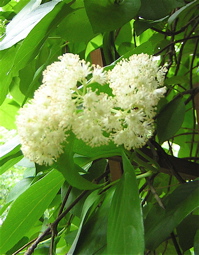Mulberry Woods Native Plant Nursery Newsletter
February 2011
Volume II, Number 2.
A Vamp for Valentines, Freezing Seeds, Killer Compost, and Squirrels a Flying
Gentle Readers,
February is NSWAM, or National Schizophrenic Weather Awareness Month. Actually I just made up all of that, but it might as well be true. Expect wind, snow, sleet, rain, sunshine, warm weather, cold weather, and with a little luck, maybe a hailstorm as well. Only one thing is certain about February weather, as George Carlin used to say in the role of the hippy dippy weatherman: Forecast for Tonight--Dark.
A Vamp for Valentine's Day
There's nothing much better than a good vamp--Wood Vamp, that is, also known as Climbing Hydrangea (Decumaria barbara). I am not certain where the common name came from, but it could be from the fact that the plant grabs on to something with its aerial rootlets and then won't ever let go. Of course the secondary meaning for vamp is a cover, and that is something the plant does extremely well. If you have a dead Chevy out in the yard somewhere, you could plant a couple of these around it and watch it disappear, for at least nine months out of the year, anyway.
While Climbing Hydrangea is not an actual member of the genus Hydrangea, it is related closely enough to be mistaken for a Hydrangea when in bloom. The plant does not have the sterile bracts that make Hydrangea species like Hydrangea quercifolia so showy, and so the floral display is short lived. But Climbing Hydangea makes up for this shortcoming by having decorative leaves and crazy randomly twisted branches that provide interest after the first cold weather strips the plant of its foliage.
The final appeal of Climbing Hydrangea is its rambling growth habit. Used as a groundcover the vine will crawl and root itself all around as long as it has sufficient water. At the same time it is not an aggressive grower and thus seldom gets out of hand. As an upright vine it is at its most showy, as it attempts to climb up out of the canopy into the sun so that it can start blooming (ground dwelling Climbing Hydrangea will not bloom). Don't be surprised to see Climbing Hydrangea reach as high as thirty feet in the air. And don't ever, ever, let it climb up a painted surface, unless you really really like to paint.
The best news as far as we are concerned is if you want one, we have them. In fact, we have near blooming sized plants for the same price that other nurseries sell little barely rooted twiggies. For more details visit our website (http://mulberrywoodsnursery.com).
Production Notes
If you have native plant seeds planted in pots outside, and think because of the weather you should bring them inside, all I can say is DON'T. Our natives are adapted to this freezing/thawing cycle, which in fact helps break open hard seed coats to allow germination. As a case in point, I planted fresh seed of Clematis reticulata, one of our native leather flowers, outside in September. Imagine my surprise when I found they had already germinating by the first week of January! I couldn't resist the temptation to bring them in and let them start growing under artificial light. The seeds that had already germinated are now small plants a couple of inches tall, but no additional seed has germinated. I have obviously sacrificed numbers of plants merely in the interest of instant gratification.
An Incredibly Strange But Disturbingly True Gardening Story
The Disturbingly True Gardening Story is back with a vengeance! All that time off has let it develop from the merely strange into the potentially deadly. It's bad enough that we have to worry about everything from snow to global warming to this year's coming (inevitable) summer time drought. Now there's a new threat--killer compost. I don't mean compost so good that it's killer; I mean compost that can literally kill you. The BBC has the scoop right here (http://www.bbc.co.uk/news/health-11167176).
I really do live way out in the woods, and keep country hours, up weekdays at 5:15 A.M. The other day I awoke at 5 A.M. to the sound of little tiny claws scratching on metal. I knew what it was, but managed to sleep all the way until 5:05 anyway. I got up, went downstairs, opened the catalytic unit on my woodstove, and waited until the varmint crawled out of the stovepipe down into my stove. It was, of course, an Eastern Flying Squirrel that had mistaken my chimney for a knothole while gliding through the neighborhood.
This winter the Flying Squirrels are here in force and have taken to using our house as a launching pad. They spend hours scampering around on our roof some nights before jumping off into the great beyond. This little fellow, however, as I looked at him through the glass door of our stove, had an expression which can only be described as "panicked like a flying squirrel trapped in a woodstove." I followed protocol and opened the front door to give him a clear escape route. When I opened the stove door he decided to glide for it, and launched himself toward the front door.
Unfortunately he had about eight inches of height to launch from, glided for only about six, hit our slate hearth with a whack, and bounced like a dead cat. Undeterred by such a minor setback, he immediately jumped up and ran out the door onto our deck. And from there, he launched himself once again into the great Flying Squirrel beyond.
The Fine Print
All newsletters will also be posted and archived on our blog for those who wish to add a public comment. Anyone irritated, annoyed, or in any way flummoxed by this newsletter should email me, Jeff Cupp, through the website http://mulberrywoodsnursery.com and be forever removed from this mailing list.
Monday, February 14, 2011
Subscribe to:
Comments (Atom)
